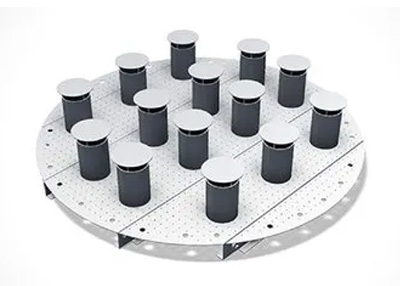
Liquid-Liquid Extraction Process is a specialized separation process employed when simpler methods like distillation are insufficient to meet specific requirements. In Liquid-Liquid Extraction process, components are extracted from a feed mixture using a solvent, without the need for an evaporation step. Liquid-Liquid Extraction Distributors are integral to this process, as they are used in extraction columns to manage both continuous and dispersed phases. These Liquid Liquid Extraction Distributors play a crucial role in preventing emulsions, especially at low surface tensions, ensuring efficient phase separation and improved extraction performance. This makes Liquid-Liquid Extraction a preferred choice in industries where precise separation is essential.
Global Export of Liquid-Liquid Extraction Distributors
Ambani Metals is a trusted manufacturer and global exporter of liquid-liquid extraction distributors, designed to ensure uniform distribution of immiscible liquid phases in extraction and separation columns. These precision-engineered internals are crucial for optimizing mass transfer, phase contact area, and column efficiency in liquid-liquid extraction systems used across chemical, pharmaceutical, and petrochemical industries.
Our extraction distributors are available in various styles, pipe-type, spray-type, channel-type, or perforated plate, type—based on flow rates, interfacial tension, and density difference between the two liquid phases. Constructed from high-performance materials like SS 316L, Duplex, Hastelloy, Inconel, and other corrosion-resistant alloys, our distributors are built to withstand challenging operating conditions in both batch and continuous systems.
With international supply capabilities, Ambani Metals exports liquid-liquid extraction distributors to over 40 countries, delivering column internals that meet stringent process requirements and global engineering standards.
- Middle East: Bahrain, Egypt, Israel, Jordan, Kuwait, Lebanon, Oman, Qatar, Saudi Arabia, and the United Arab Emirates
- Africa: Morocco, Tunisia, Ghana, Nigeria, Senegal, Kenya, Mauritius, Rwanda, Tanzania, Uganda, Zambia, Botswana, Eswatini, Lesotho, Namibia, and South Africa
- Europe: Germany, United Kingdom, France, Italy, Netherlands, Spain, Belgium, Poland, Czech Republic, Sweden, Denmark, Finland, Portugal, Hungary, Slovakia, Slovenia, Romania, and Austria
- Asia: Japan, South Korea, Singapore, Malaysia, Vietnam, Indonesia, Thailand, Philippines, Bangladesh, Sri Lanka, and Nepal
- Pan-Pacific Countries: United States, Canada, Mexico, Brazil, Chile, Colombia, Peru, Panama, Australia, and New Zealand
Why Choose Ambani Metals?
- Designed to suit two-phase systems with varying viscosity and density
- Superior corrosion resistance and precision fabrication
- Custom configurations for vertical or horizontal extraction columns
- Technical support from design to delivery
Whether you're upgrading a liquid-liquid extraction system or commissioning a new unit, Ambani Metals delivers high-performance extraction distributors tailored to your column and process conditions—shipped worldwide with complete documentation and support.
FAQs
A Liquid-Liquid Extraction Distributor is a device used in the process of liquid-liquid extraction to evenly distribute the feed mixture (comprising of two immiscible liquids) across the extraction column. This ensures optimal contact and mass transfer between the two phases, enhancing the efficiency of the extraction process.
The distributor functions by evenly distributing the incoming liquid feed into fine droplets or streams. This is typically achieved through various designs like perforated plates, packed beds, or rotating disks. The key goal is to maximize the surface area for contact between the two immiscible liquids, which facilitates efficient mass transfer of solutes from one phase to the other.
Uniform distribution is crucial because it ensures that the two liquid phases have maximum contact area, leading to more effective mass transfer. Non-uniform distribution can result in poor extraction efficiency, as some parts of the column may have insufficient mixing, leading to inadequate separation of the desired compounds.
